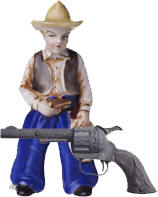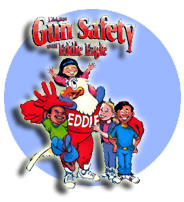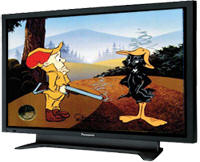|
 As
parents we've been involved
with gun safety for children far longer than most
other people. As gun owners and teachers safety is our own foremost concern.
We think that safety should be your primary concern
too—especially if you're the parent, grandparent,
or relative of a young child—even if you
are not a gun owner or don't shoot. As
parents we've been involved
with gun safety for children far longer than most
other people. As gun owners and teachers safety is our own foremost concern.
We think that safety should be your primary concern
too—especially if you're the parent, grandparent,
or relative of a young child—even if you
are not a gun owner or don't shoot.
We start every class
we teach with a focused review of gun safety
rules. We're serious about what we do, and what
we do is help people learn to protect themselves and their
families, which brings us back to safety once
again.
Common sense should make it
obvious that people who know and use firearms are
those most committed to gun safety and most capable
of practicing it. Americans have used firearms safely
since before this country was founded. We really
don't need direction from people who know little
more about guns than what they see on television
or hear from politicians. The NRA and its members
have always been the leaders in ensuring the safety
of children around guns. We continue that tradition
in every class we teach.
And so we've adapted this
page of "Information for Parents" from the NRA's
"Parents' Guide to Gun Safety." As the NRA states
about the original page, it "is not intended as
a complete course in gun safety and is not a substitute
for formal, qualified instruction in the handling,
use, or storage of firearms. The guidelines herein
should be considered options to minimize the chance
of an accident occurring in the home." (Now is a
good time to join the NRA or to renew your annual
membership through us at a substantial discount.
Join or renew your NRA membership at a substantial discount now.)
Keep in mind that it is your
responsibility--not ours or anyone else's--to determine
the best gun safety practices for your family situation:
we can't know your situation as well as you. We
therefore can only present information, not endorse
it for your situation. The following overview can
help you make a good start on understanding your
needs.
See how the NRA's Eddie Eagle program can help
you teach very young children real gun safety
in the real world.
Parents Guide to Gun Safety
Parents play a key role in developing safe practices
and are ultimately responsible for the behavior
and safety of their children. Because isolated lessons
and concepts can be quickly forgotten, repetition
will help children remember standard safety procedures.
Top of Page
The Parents' Responsibility
 In
a home where guns are kept, the degree of safety
a child has rests squarely on the child's parents. In
a home where guns are kept, the degree of safety
a child has rests squarely on the child's parents.
Parents who accept the responsibility to learn,
practice and teach gun safety rules will ensure
their child's safety to a much greater extent than
those who do not. Parental responsibility does not
end, however, when the child leaves the home.
According to federal statistics, there are guns
in approximately half of all U.S. households. Even
if no one in your family owns a gun, chances are
that someone you know does. Your child could come
in contact with a gun at a neighbor's house, when
playing with friends, or under other circumstances
outside your home.
It is critical for your child to know what to
do if he or she encounters a firearm anywhere, and
it is the parents' responsibility to provide that
training.
Top of Page
Talking With Your Child About
Gun Safety

There is no particular age to talk with your
child about gun safety. A good time to introduce
the subject is the first time he or she shows an
interest in firearms, even toy pistols or rifles.
Talking openly and honestly about gun safety with
your child is usually more effective than just ordering
him or her to "Stay out of the gun closet," and
leaving it at that. Such statements may just stimulate
a child's natural curiosity to investigate further.
As with any safety lesson, explaining the rules
and answering a child's questions help remove the
mystery surrounding guns. Any rules set for your
own child should also apply to friends who visit
the home. This will help keep your child from being
pressured into showing a gun to a friend.
Top of Page
Toy Guns vs. Real Guns
 It
is also advisable, particularly with very young
children, to discuss gun use on television as opposed
to gun use in real life. Firearms are often handled
carelessly in movies and on TV. Additionally, children
see TV and movie characters shot and "killed" with
well-documented frequency. When a young child sees
that same actor appear in another movie or TV show,
confusion between entertainment and real life may
result. It may be a mistake to assume that your
child knows the difference between being "killed"
on TV and in reality. It
is also advisable, particularly with very young
children, to discuss gun use on television as opposed
to gun use in real life. Firearms are often handled
carelessly in movies and on TV. Additionally, children
see TV and movie characters shot and "killed" with
well-documented frequency. When a young child sees
that same actor appear in another movie or TV show,
confusion between entertainment and real life may
result. It may be a mistake to assume that your
child knows the difference between being "killed"
on TV and in reality.
If your child has toy guns, you may want to use
them to demonstrate safe gun handling and to explain
how they differ from genuine firearms. Even though
an unsupervised child should not have access to
a gun, there should be no chance that he or she
could mistake a real gun for a toy.
Top of Page
What Should You Teach Your Child
About Gun Safety?
If you have decided that your child is not ready
to be trained in a gun's handling and use, teach
him or her to follow the instructions of NRA's Eddie
Eagle GunSafe® Program.
If you find a gun:
STOP!
Don't Touch.
Leave the Area.
Tell an Adult.
The initial steps of "Stop" and "Don't Touch"
are the most important. To counter the natural impulse
to touch a gun, it is imperative that you impress
these steps of the safety message upon your child.
 In
today's society, where adult supervision is not
always possible, the direction to "Leave the Area"
is also essential. Under some circumstances, area
may be understood to be a room if your child cannot
physically leave the apartment or house. "Tell an
Adult" emphasizes that children should seek a trustworthy
adult, neighbor, relative or teacher -- if a parent
or guardian is not available. In
today's society, where adult supervision is not
always possible, the direction to "Leave the Area"
is also essential. Under some circumstances, area
may be understood to be a room if your child cannot
physically leave the apartment or house. "Tell an
Adult" emphasizes that children should seek a trustworthy
adult, neighbor, relative or teacher -- if a parent
or guardian is not available.
The NRA's Eddie Eagle GunSafe Program includes
an instructor guide, activity books, poster, and
an animated video to explain its four-step safety
message.
Preview the Eddie Eagle animated video and gun safety information
for very young children. For
how to get the Eddie Eagle program
visit
http:// www.nrahq.org/safety/eddie or call (800)
231-0752.
Top of Page
Basic Gun Safety Rules

Although the NRA has complete gun safety rules available
for specific types of firearm use (hunting and competition,
for example, the following three rules are fundamental
in any situation. Whether or not you own a gun,
it is important to know these rules so that you
may insist that others follow them.
- Always keep the gun pointed in a safe direction.
Whether you are shooting or simply handling
a gun, never point it at yourself or others.
Common sense will tell you which direction is
the safest. Outdoors, it is generally safe to
point the gun toward the ground, or, if you
are at a shooting range, toward the target.
Indoors, be mindful of the fact that a bullet
can penetrate ceilings, floors, walls, windows,
and doors.
- Always keep your finger off the trigger
until ready to shoot. When holding a gun, rest
your trigger finger outside the trigger guard
alongside the gun. Until you are actually ready
to fire, do not touch the trigger.
- Always keep the gun unloaded until ready
to use. If you do not know how to check to see
if a gun is unloaded, leave it alone. Carefully
secure it, being certain to point it safely
and to keep your finger off the trigger, and
seek competent assistance.
Click here
for the NRA's complete gun safety rules. In South Carolina the South
Carolina Law Enforcement Division (SLED) requires
CWP (Concealed Weapons Permit) applicants to know
its gun safety rules too.
Click here
for SLED's gun safety rules.
Top of Page
Where to Get Training
 The
time may come when you or your family members want
to learn how to handle and shoot a gun safely. In
the case of a child, his or her attitude, learning
ability, and physical and emotional maturity are
some of the factors to be weighed before allowing
formal instruction to begin. The
time may come when you or your family members want
to learn how to handle and shoot a gun safely. In
the case of a child, his or her attitude, learning
ability, and physical and emotional maturity are
some of the factors to be weighed before allowing
formal instruction to begin.
Providing instruction in the safe handling, use,
and storage of firearms is one of the NRA's most
important functions. Basic Firearm Training Courses,
taught by over 54,000 NRA Certified Instructors,
are offered in every state.
We at Paladin Services
offer that Basic Firearm Training Course—our
CWP/Basic Pistol course—for South Carolina. Qualified
adults can use our class to meet firearms safety
and concealed weapons permit requirements for South
Carolina, Florida, and other states. You also can
take our course for NRA Basic Pistol credit only
and without applying for a CWP. We may accept responsible
young people qualified under state law, accompanied
by a parent, and with written parental permission.
Click here for information about our combined
CWP and Basic Pistol course, which is a firearms
safety class.
Top of Page
Gun Owners' Responsibilities
Most states impose some form of legal duty on
adults to take reasonable steps to deny access by
children to dangerous substances or instruments.
It is the individual gun owner's responsibility
to understand and follow all laws regarding gun
purchase, ownership, storage, transport, etc. Contact
your state police and/or local police for information
regarding such laws. If you own a gun and do not
know how to operate it, do not experiment with it.
Point it in a safe direction, keep your finger off
the trigger, and store it securely. Seek competent
assistance and instruction at once. An untrained
adult can be as dangerous as a curious child.
Store guns so that they are inaccessible to children
and other unauthorized users. Gun shops sell a wide
variety of safes, cases, and other security devices.
While specific security measures may vary, a parent
must, in every case, assess the exposure of the
firearm and absolutely ensure that it is inaccessible
to a child.
|